并购中目标公司价值评估案例研究定稿版
- 格式:docx
- 大小:244.31 KB
- 文档页数:130
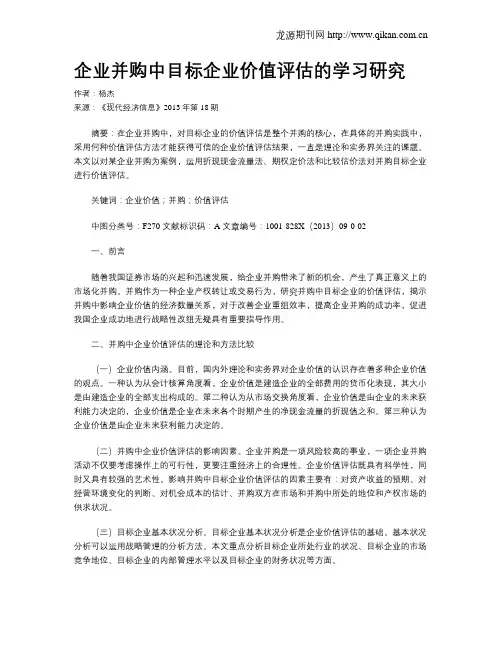
企业并购中目标企业价值评估的学习研究作者:杨杰来源:《现代经济信息》2013年第18期摘要:在企业并购中,对目标企业的价值评估是整个并购的核心,在具体的并购实践中,采用何种价值评估方法才能获得可信的企业价值评估结果,一直是理论和实务界关注的课题。
本文以对某企业并购为案例,运用折现现金流量法、期权定价法和比较估价法对并购目标企业进行价值评估。
关键词:企业价值;并购;价值评估中图分类号:F270 文献标识码:A 文章编号:1001-828X(2013)09-0-02一、前言随着我国证券市场的兴起和迅速发展,给企业并购带来了新的机会,产生了真正意义上的市场化并购。
并购作为一种企业产权转让或交易行为,研究并购中目标企业的价值评估,揭示并购中影响企业价值的经济数量关系,对于改善企业重组效率,提高企业并购的成功率,促进我国企业成功地进行战略性改组无疑具有重要指导作用。
二、并购中企业价值评估的理论和方法比较(一)企业价值内涵。
目前,国内外理论和实务界对企业价值的认识存在着多种企业价值的观点。
一种认为从会计核算角度看,企业价值是建造企业的全部费用的货币化表现,其大小是由建造企业的全部支出构成的。
第二种认为从市场交换角度看,企业价值是由企业的未来获利能力决定的,企业价值是企业在未来各个时期产生的净现金流量的折现值之和。
第三种认为企业价值是由企业未来获利能力决定的。
(二)并购中企业价值评估的影响因素。
企业并购是一项风险较高的事业,一项企业并购活动不仅要考虑操作上的可行性,更要注重经济上的合理性。
企业价值评估既具有科学性,同时又具有较强的艺术性。
影响并购中目标企业价值评估的因素主要有:对资产收益的预期、对经营环境变化的判断、对机会成本的估计、并购双方在市场和并购中所处的地位和产权市场的供求状况。
(三)目标企业基本状况分析。
目标企业基本状况分析是企业价值评估的基础。
基本状况分析可以运用战略管理的分析方法。
本文重点分析目标企业所处行业的状况、目标企业的市场竞争地位、目标企业的内部管理水平以及目标企业的财务状况等方面。
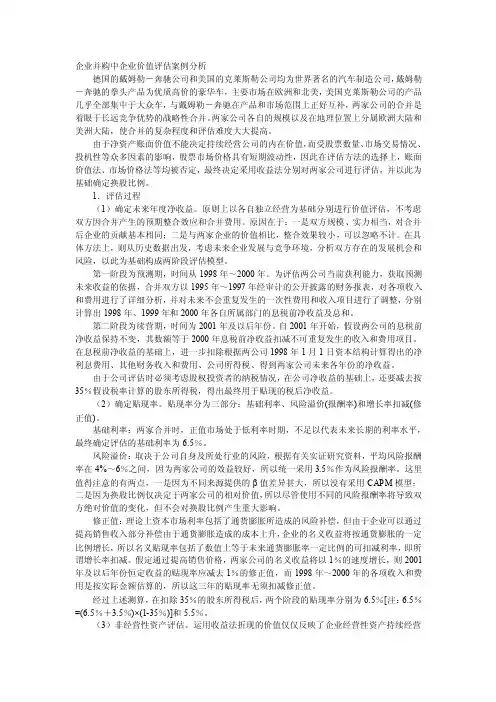
企业并购中企业价值评估案例分析德国的戴姆勒-奔驰公司和美国的克莱斯勒公司均为世界著名的汽车制造公司,戴姆勒-奔驰的拳头产品为优质高价的豪华车,主要市场在欧洲和北美,美国克莱斯勒公司的产品几乎全部集中于大众车,与戴姆勒-奔驰在产品和市场范围上正好互补,两家公司的合并是着眼于长远竞争优势的战略性合并。
两家公司各自的规模以及在地理位置上分属欧洲大陆和美洲大陆,使合并的复杂程度和评估难度大大提高。
由于净资产账面价值不能决定持续经营公司的内在价值,而受股票数量、市场交易情况、投机性等众多因素的影响,股票市场价格具有短期波动性,因此在评估方法的选择上,账面价值法、市场价格法等均被否定,最终决定采用收益法分别对两家公司进行评估,并以此为基础确定换股比例。
1.评估过程(1)确定未来年度净收益。
原则上以各自独立经营为基础分别进行价值评估,不考虑双方因合并产生的预期整合效应和合并费用。
原因在于:一是双方规模、实力相当,对合并后企业的贡献基本相同;二是与两家企业的价值相比,整合效果较小,可以忽略不计。
在具体方法上,则从历史数据出发,考虑未来企业发展与竞争环境,分析双方存在的发展机会和风险,以此为基础构成两阶段评估模型。
第一阶段为预测期,时间从1998年~2000年。
为评估两公司当前获利能力,获取预测未来收益的依据,合并双方以1995年~1997年经审计的公开披露的财务报表,对各项收入和费用进行了详细分析,并对未来不会重复发生的一次性费用和收入项目进行了调整,分别计算出1998年、1999年和2000年各自所属部门的息税前净收益及总和。
第二阶段为续营期,时间为2001年及以后年份。
自2001年开始,假设两公司的息税前净收益保持不变,其数额等于2000年息税前净收益扣减不可重复发生的收入和费用项目。
在息税前净收益的基础上,进一步扣除根据两公司1998年1月1日资本结构计算得出的净利息费用、其他财务收入和费用、公司所得税、得到两家公司未来各年份的净收益。
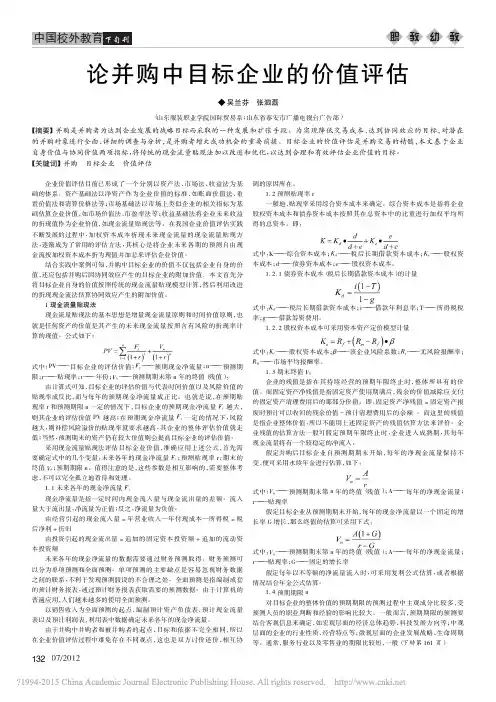
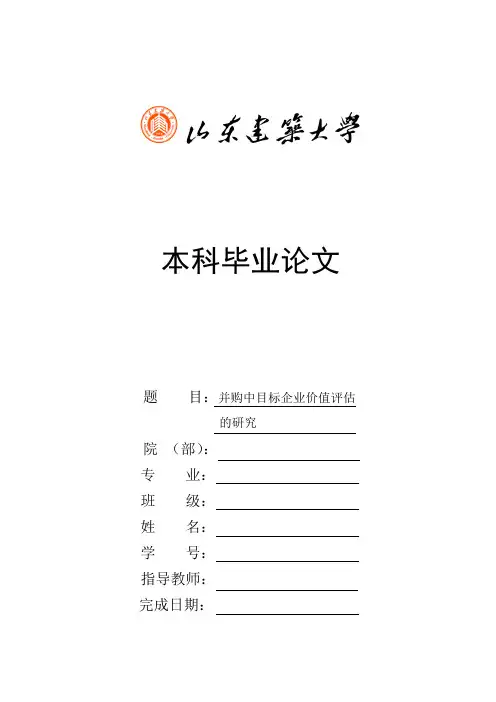
本科毕业论文题目:并购中目标企业价值评估的研究院(部):专业:班级:姓名:学号:指导教师:完成日期:山东建筑大学毕业论文目录摘要 (III)ABSTRACT (IV)1前言 (1)1.1研究背景及意义 (1)1.2国内外研究状况综述 (1)1.2.1国外研究状况 (1)1.2.2国内研究状况 (2)2企业并购及价值评估的含义 (3)2.1企业并购的含义 (3)2.2企业价值及价值评估的含义 (3)3企业价值评估方法 (4)3.1成本法 (4)3.1.1成本法概述 (4)3.2.1成本法的缺陷及适用条件 (5)3.2市场法 (5)3.2.1市场法概述 (5)3.2.2市场比较法 (5)3.2.3市场法的缺陷及适用条件 (6)3.3收益现值法 (6)3.3.1收益现值法概述 (6)3.3.2现金流量贴现法 (7)3.2.3收益现值法的缺陷及适用条件 (7)3.4实物期权法 (7)3.4.1实物期权法概述 (7)3.4.2实物期权法的缺陷及适用条件 (8)I山东建筑大学毕业论文4案例分析 (8)4.1案例背景介绍 (8)4.2并购的效应分析 (9)4.2.1百胜的发展战略 (9)4.2.2小肥羊的市场占有率和盈利能力 (9)4.3并购定价分析 (9)4.3.1账面价值法 (9)4.3.2市盈率法 (10)4.3.3现金流量贴现法 (11)4.4案例小结 (13)5我国企业并购中价值评估存在的问题及对策 (13)5.1我国企业并购中价值评估存在的问题 (13)5.2完善我国企业并购中价值评估的建议 (14)6结论 (15)谢辞 (17)参考文献 (18)II山东建筑大学毕业论文摘要企业并购是市场经济发展的必然结果,是实现产业升级和资源优化配置的重要方式。
在企业并购过程中,对目标企业的估价是至关重要的一环,准确地把握目标企业的真实价值,对并购能否成功有着巨大的影响。
本文在结合目前国内外企业价值评估理论的基础上,对成本法,市场法,收益法和实物期权法等四种企业价值评估方法的介绍和比较,分析各种企业价值评估方法应用的前提条件和适用范围以及其在企业价值评估中的不足,认为应该根据企业的具体特征,选择合适的评估方法进行企业价值评估。
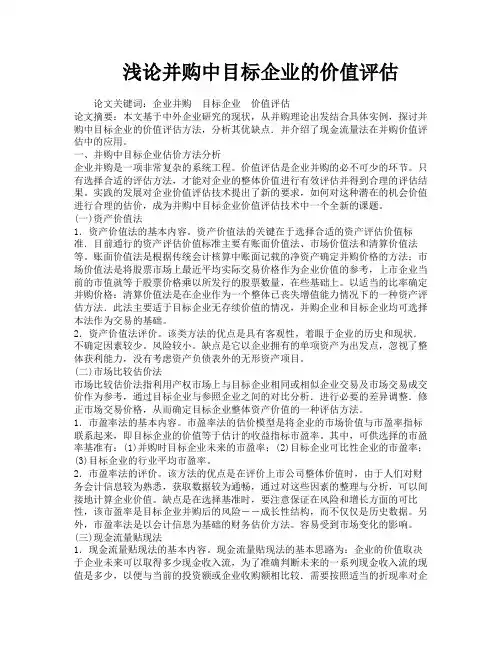
浅论并购中目标企业的价值评估论文关键词:企业并购目标企业价值评估论文摘要:本文基于中外企业研究的现状,从并购理论出发结合具体实例,探讨并购中目标企业的价值评估方法,分析其优缺点.并介绍了现金流量法在并购价值评估中的应用。
一、并购中目标企业估价方法分析企业并购是一项非常复杂的系统工程。
价值评估是企业并购的必不可少的环节。
只有选择合适的评估方法,才能对企业的整体价值进行有效评估并得到合理的评估结果。
实践的发展对企业价值评估技术提出了新的要求,如何对这种潜在的机会价值进行合理的估价,成为并购中目标企业价值评估技术中一个全新的课题。
(一)资产价值法1.资产价值法的基本内容。
资产价值法的关键在于选择合适的资产评估价值标准.目前通行的资产评估价值标准主要有账面价值法、市场价值法和清算价值法等。
账面价值法是根据传统会计核算中账面记载的净资产确定并购价格的方法;市场价值法是将股票市场上最近平均实际交易价格作为企业价值的参考,上市企业当前的市值就等于股票价格乘以所发行的股票数量,在些基础上。
以适当的比率确定并购价格:清算价值法是在企业作为一个整体已丧失增值能力情况下的一种资产评估方法.此法主要适于目标企业无存续价值的情况,并购企业和目标企业均可选择本法作为交易的基础。
2.资产价值法评价。
该类方法的优点是具有客观性,着眼于企业的历史和现状.不确定因素较少。
风险较小。
缺点是它以企业拥有的单项资产为出发点,忽视了整体获利能力,没有考虑资产负债表外的无形资产项目。
(二)市场比较估价法市场比较估价法指利用产权市场上与目标企业相同或相似企业交易及市场交易成交价作为参考,通过目标企业与参照企业之间的对比分析.进行必要的差异调整.修正市场交易价格,从而确定目标企业整体资产价值的一种评估方法。
1.市盈率法的基本内容。
市盈率法的估价模型是将企业的市场价值与市盈率指标联系起来,即目标企业的价值等于估计的收益指标市盈率。
其中,可供选择的市盈率基准有:(1)并购时目标企业未来的市盈率;(2)目标企业可比性企业的市盈率;(3)目标企业的行业平均市盈率。
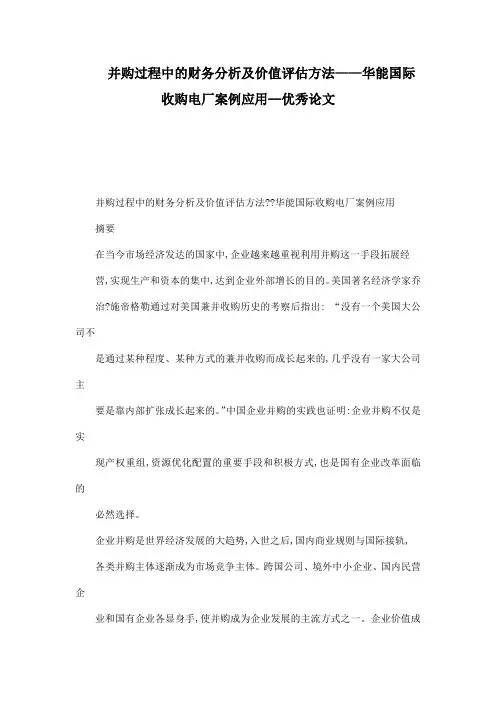
并购过程中的财务分析及价值评估方法——华能国际收购电厂案例应用--优秀论文并购过程中的财务分析及价值评估方法??华能国际收购电厂案例应用摘要在当今市场经济发达的国家中,企业越来越重视利用并购这一手段拓展经营,实现生产和资本的集中,达到企业外部增长的目的。
美国著名经济学家乔治?施帝格勒通过对美国兼并收购历史的考察后指出: “没有一个美国大公司不是通过某种程度、某种方式的兼并收购而成长起来的,几乎没有一家大公司主要是靠内部扩张成长起来的。
”中国企业并购的实践也证明:企业并购不仅是实现产权重组,资源优化配置的重要手段和积极方式,也是国有企业改革面临的必然选择。
企业并购是世界经济发展的大趋势,入世之后,国内商业规则与国际接轨, 各类并购主体逐渐成为市场竞争主体。
跨国公司、境外中小企业、国内民营企业和国有企业各显身手,使并购成为企业发展的主流方式之一。
企业价值成市场交易的主题,交易增值成为商业社会的目标,通过并购实现资源的优化配置。
财务问题是企业并购的核心问题,这是因为一切并购活动都要达到一定的财务目标。
而估值与定价又是并购活动中最重要的部分之一。
随着市场环境的完善和参与者观念的改变,以价值发现为基础的并购在中国正逐步被接受,如何正确的评估一个企业的价值成为并购成功与否的关键。
企业并购要取得成功,首要问题是做好事前的决策分析,而决策的核心是评估并购能否创造价值。
收购企业要估计目标企业的合理价格,在决定收购价格时要对并购前后的价值变动进行评估,以判断收购能否增加股东财富,以及依靠什么来赠加股东财富。
价值评估是一种经济“评估”方法。
评估不同于“计算”。
评估是一种定量分析,但它并不是完全客观的科学的。
一方面它使用许多定量分析模型,具有一定的科学性和客观性;另一方面它又使用许多主观估计的数据,带有一定的主观估计性质。
因此,要尽量保证评估的准确性,对评估人员的经验、可获得信息的充分性要求就很高。
正由于评估的这种特性,鉴于本人认识能力和可取资源的的限制,评估误差也是不可避免的,这也正是本文的局限性所在。
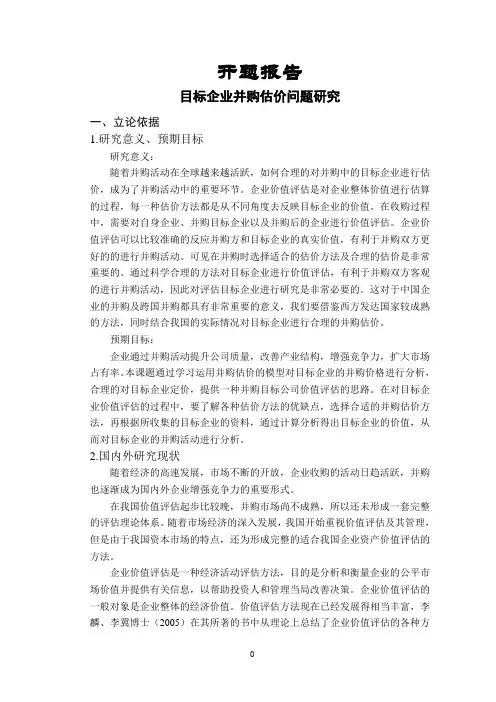
开题报告目标企业并购估价问题研究一、立论依据1.研究意义、预期目标研究意义:随着并购活动在全球越来越活跃,如何合理的对并购中的目标企业进行估价,成为了并购活动中的重要环节。
企业价值评估是对企业整体价值进行估算的过程,每一种估价方法都是从不同角度去反映目标企业的价值。
在收购过程中,需要对自身企业、并购目标企业以及并购后的企业进行价值评估。
企业价值评估可以比较准确的反应并购方和目标企业的真实价值,有利于并购双方更好的的进行并购活动。
可见在并购时选择适合的估价方法及合理的估价是非常重要的。
通过科学合理的方法对目标企业进行价值评估,有利于并购双方客观的进行并购活动,因此对评估目标企业进行研究是非常必要的。
这对于中国企业的并购及跨国并购都具有非常重要的意义,我们要借鉴西方发达国家较成熟的方法,同时结合我国的实际情况对目标企业进行合理的并购估价。
预期目标:企业通过并购活动提升公司质量,改善产业结构,增强竞争力,扩大市场占有率。
本课题通过学习运用并购估价的模型对目标企业的并购价格进行分析,合理的对目标企业定价,提供一种并购目标公司价值评估的思路。
在对目标企业价值评估的过程中,要了解各种估价方法的优缺点,选择合适的并购估价方法,再根据所收集的目标企业的资料,通过计算分析得出目标企业的价值,从而对目标企业的并购活动进行分析。
2.国内外研究现状随着经济的高速发展,市场不断的开放,企业收购的活动日趋活跃,并购也逐渐成为国内外企业增强竞争力的重要形式。
在我国价值评估起步比较晚,并购市场尚不成熟,所以还未形成一套完整的评估理论体系。
随着市场经济的深入发展,我国开始重视价值评估及其管理,但是由于我国资本市场的特点,还为形成完整的适合我国企业资产价值评估的方法。
企业价值评估是一种经济活动评估方法,目的是分析和衡量企业的公平市场价值并提供有关信息,以帮助投资人和管理当局改善决策。
企业价值评估的一般对象是企业整体的经济价值。
价值评估方法现在已经发展得相当丰富,李麟、李冀博士(2005)在其所著的书中从理论上总结了企业价值评估的各种方法,并且对价值评估方法的适用性以及局限性做出了相对充分的理论研究,以企业的价值最大化为核心,详细的分析了如何对目标企业价值评估。

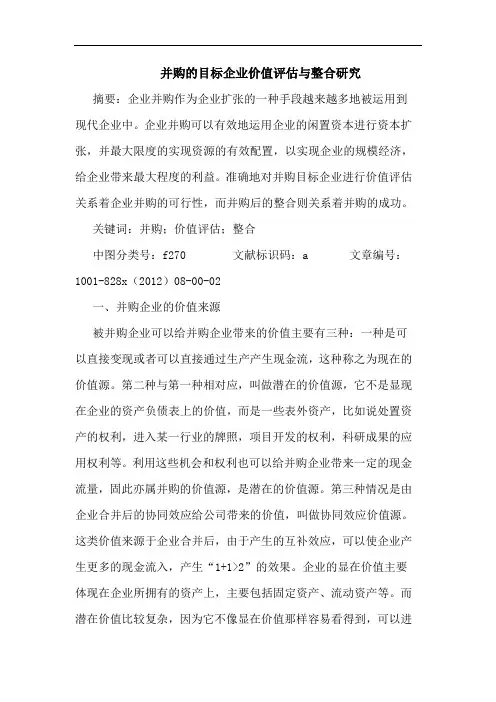
并购的目标企业价值评估与整合研究摘要:企业并购作为企业扩张的一种手段越来越多地被运用到现代企业中。
企业并购可以有效地运用企业的闲置资本进行资本扩张,并最大限度的实现资源的有效配置,以实现企业的规模经济,给企业带来最大程度的利益。
准确地对并购目标企业进行价值评估关系着企业并购的可行性,而并购后的整合则关系着并购的成功。
关键词:并购;价值评估;整合中图分类号:f270 文献标识码:a 文章编号:1001-828x(2012)08-00-02一、并购企业的价值来源被并购企业可以给并购企业带来的价值主要有三种:一种是可以直接变现或者可以直接通过生产产生现金流,这种称之为现在的价值源。
第二种与第一种相对应,叫做潜在的价值源,它不是显现在企业的资产负债表上的价值,而是一些表外资产,比如说处置资产的权利,进入某一行业的牌照,项目开发的权利,科研成果的应用权利等。
利用这些机会和权利也可以给并购企业带来一定的现金流量,固此亦属并购的价值源,是潜在的价值源。
第三种情况是由企业合并后的协同效应给公司带来的价值,叫做协同效应价值源。
这类价值来源于企业合并后,由于产生的互补效应,可以使企业产生更多的现金流入,产生“1+1>2”的效果。
企业的显在价值主要体现在企业所拥有的资产上,主要包括固定资产、流动资产等。
而潜在价值比较复杂,因为它不像显在价值那样容易看得到,可以进行很好的价值评估,比如说企业的无形资产,企业的运转状况,企业的人力资源管理、创新研究等。
协同效应是指并购后企业的总体效益大于并购前企业独自经营的效益之和部分,它的价值评估需要建立在对并购企业整合以后的经营运转状况上。
二、企业价值评估步骤第一步首先要明白企业价值评估的目标,即作为持续经营的被并购企业的整体价值。
第二步,收集资料。
外部的资料主要包括宏观经济资料,比如宏观经济政策对企业的生存环境的利弊;产业发展状况;行业竞争格局和企业所处的行业地位。
内部资料主要指企业的财务报表,资产与人力资源状况表等。

浅谈并购中的目标企业价值评估研究近年来,无论是海外并购还是国内并购,企业间的并购行为越来越多,那么并购中对于企业价值的评估显得尤为重要,本文探讨并购中常用的企业价值评估方法,对其优缺点进行分析比较,为并购中的企业价值评估给出较为合理的建议。
标签:并购;价值评估;现金流量折现法;相对价值模型一、前言近几年,光明、伊利等乳业巨头通过海外跨国并购纷纷落地于澳大利亚、新西兰;2015年3月,锦江集团通过收购法国卢浮酒店而深入欧洲酒店市场;2015年8月,“有妖气”-中国第一原创动平台被奥飞动漫收购100%股权……近年来,企业间的并购案层出不穷,无论是国内企业之间的并购,还是国内企业通过并购走出去,亦或是外资并购国内企业打入中国市场,这样的案例层出不穷。
然而,并购同时是把双刃剑,如何评估存在的风险不可小觑。
并购过程中对于目标企业的价值评估则显得尤为重要,评估出的价值直接成为该次并购的决策基础和决定成败的关键。
作为一种经济评估的方法,企业价值评估一般用来衡量和分析目标企业的市场公允价值,为内部管理当局和外部投资人制定和改善相关决策而提供有关信息,藉以同时服务于内外部利益相关者。
那么企业现在有哪些价值评估方法呢?目前业界主要的企业价值评估方法有:现金流量折现法和相对估价法。
本文就两种方法的优缺点进行比较分析。
二、现金流量折现法1.相关的现金流量测算原则与方法衡量一个企业的价值,准确的说是运用其现金流而非选用会计利润来进行。
当前公司的价值应等于其日常运营活动所产生各种未来的不确定的现金流量,用以相应的折现率调整的加总之和,折现率因为风险不同而具有不同性。
一般估值选用两阶段股利贴现模型,两阶段股利贴现模型适用于增长呈两个阶段的企业:第一阶段高速增长且准确预测,第二阶段呈平稳发展。
这种适用于并购中的很多类型的企业。
2.现金流量折现法的优缺点作为主流的价值评估方法,其优点在于:(1)较之利润,现金流量的优点是可操纵性差,客观性较强。
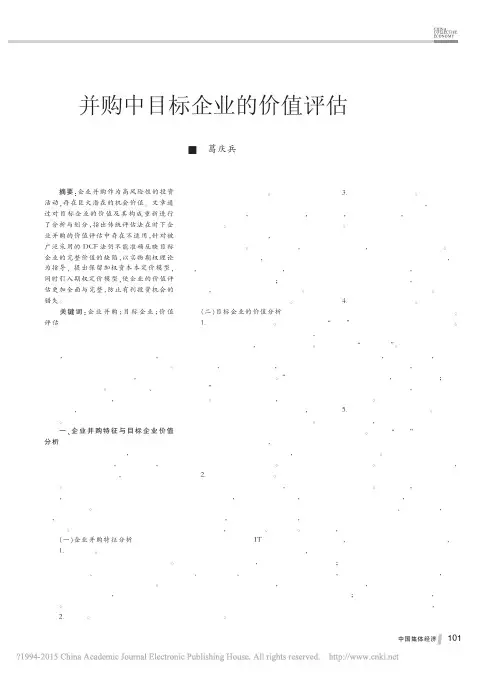
企业并购中目标企业价值评估问题研究一、引言在当今的世界中,并购已然变成企业扩大市场,朝着更强的地位发展的康庄大道。
例如东方集团收购锦州港成就上市发展之路,西门子收购锦西化机透平分厂彻底消除了中国本土一个强大的竞争对手,华为并购港湾实现价值最大化等。
企业并购进入实质性操作阶段后,首先要解决的是并购资产的价值评估、并购价格的确定的问题,然后是并购资金的筹集和支付等问题。
这些也是双方最关心、最敏感的问题。
能否确定双方满意的交易价格,决定着并购活动的能否进行下去。
若是将并购的价格定的过高,将给并购一方带来更大的成本和融资压力,给并购后的企业发展留下隐患。
反之,如果并购价格过低,被并购方可能会因为得到的补偿太少而放弃交易。
并购价格的确定需要对目标企业的价值进行大致的评估,只有对目标企业资产的价值透彻地掌握,才能确定交易价格的大致区间,并为最后确定交易价格提供参照。
综上所述,在企业并购活动中,如何确定目标企业的价值至关重要,所以在现实中,必须要选择合适的方法来确定目标企业的价值。
二、文献综述关于企业资产评估的方式,一般来说有三种,即市场法、收益法和成本法。
例如在清华大学出版社出版的《企业并购与资产重组—理论、案例与操作实务》一书中,石建勋教授(2012)是这样总结的,资产价值评估的方法一般有两种依据,一种是按照企业的资产的价值来估量,另一种呢,则是按照企业的赢利去估量。
前者依照企业资产的价值来评估的具体方法有账面价值法、清算价值法、市场价值法和重置成本法等等,而依照企业的赢利水平来评价的方式有现金流量贴现法和以收益为基础的市盈率法。
中国金融出版社出版的《企业兼并与收购》,这是境内外专家研究的成果,马瑞清等人(2011)所说的资产评估的方法也是市场法、收益法和成本法三种,但是它的大体方法下的分类有所不同。
在市场法下,大家使用得较多的两种方式是参考企业比较法和并购案例法,这两种方法的步骤都差不多,只是参照的企业的范围有所不同;在收益法下,运用得较多的是收益现值法和现金流量贴现法这两种方式;在成本法下,通常来说有重置成本法和假设开发法这两种。
書臨Zsi NESS阿里巴巴并购中的价值评估分析文/宋魏冰洁现在,大多数的企业并购都是为了实现利润最大化,增强其竞争优势,最终达到扩大销售及市场份额的目的。
互联网属于高科技行业,其最大的特征就是技术更新速度太快。
若自行开发新技术,没有一个企业可以做到随时走在各领域的最尖端,所以为了生存和发展就必须迅速吸纳所需要的技术、产品,甚至于某个市场领域和新的业务范围。
然而,吸纳的方式就是并购拥有这些资源,从而在较低的资金成本中获取发展必需的资金。
一、并购背景在竞争激烈的互联网行业中,020曾被视为最具有想象空间的市场之一,而与其他入口相比,地图对客户群体而言则是最便捷的。
位置作为连接线上与线下最为重要的渠道,其与地图行业密不可分,这也导致020市场的竞争渐渐转变成地图领域的竞争。
阿里巴巴作为互联网企业的典型代表,通过并购高德地图,避免其自建相关资源而产生成本,提高经营业绩,扩展企业的规模和范围,以获得充足的客户粘度和数据流量。
以财务的角度来讲,阿里巴巴的并购就在于提升其市场价值,争取更多的融资,从而增强企业的可持续发展能力并占据有利市场。
二、并购双方简介(一)并购方简介。
阿里巴巴网络技术有限公司1999年创立,于2014年9月19日上市,最初以马云为代表的18人团队现已成为中国境内最大的互联网企业。
良好的经营理念使得阿里巴巴团队在1999年成立之时就获得了500万美元的融资金额,次年又成功融资到2000万美元,这为其势不可挡的发展奠定了坚实的基础。
自开创至今,它通过运营多元化的经济业务,努力搭建了更加便捷、高效的互联网平台。
(二)被并购方简介。
高德软件有限公司于2002年成立,涵盖全国海量的数据库,是我国知名的数字地图、导航供应商,其高品质的位置服务已成为企业的核心竞争力。
高德软件作为Google地图、MSN地图的合作伙伴,苹果地图应用程序在中国大陆的地图数据提供商,力求给广大用户创造一个完美的位置体验。
并购中的目标企业价值评估分析———以可口可乐收购汇源果汁为例虞 力暨南大学产业经济研究院 广东 广州 510632【摘要】 采用现金流量折现法,评估汇源公司股票内在价值,并结果和可口可乐收购汇源公司报价进行比较。
研究表明: 利用现金流量折现法评估的股票内在价值达到每股 12. 98 港元,较可口可乐公司报价 12. 20 港元高出近 6% ,尽管可口可乐公司以 3 倍的价格收购,但还是具有很大的盈利空间。
【关键词】 并购 价值评估 现金流量折现法至2012 年的 191 亿公升。
面对这么庞大的市场发展潜力,作为中国 首屈一指的果汁生产商,汇源集团已稳占有利位置,把握这些市场 增长带来的宝贵机遇; 并积极在产品发展、产能增加、优化销售网 络及开拓新市场等做出策略性部署,以进一步加强汇源果汁强势的 品牌策略、不断完善的销售网络和扩大的生产规模,预计未来销售 额将随着不断增长的人均收入水平和市场需求持续稳步增长。
1、引言2008 年 9 月 3 日,汇源果汁 (1886. HK ) 发布公告,可口可乐 的一家全资附属公司以约 179. 2 亿港元,收购汇源果汁集团有限公司 股本中的全部已发行股份及全部未行使可换股债券,可口可乐提出 的收购价是每股现金 12. 20 港元,是汇源 8 月 29 日停牌前收盘价 4. 14 港元的近 3 倍。
而持有汇源果汁近 66% 股份的三大股东已对该 交易作出不可撤回的承诺①。
可口可乐用近 180 亿港元收购资产总值 为68. 87 亿元人民币的汇源果汁,在这场并购中可口可乐何以支付这 么高的溢价? 难道汇源果汁真的有这么高的价值吗? 是今日持续低 迷的股票市场掩埋了汇源果汁的真实价值,还是可口可乐急于扩展 果汁市场慌乱之中走的一步险棋? 近年来,随着全球经济一体化的 发展,跨国公司展开了新一轮并购浪潮,企图在全球范围内控制更 多的资源和市场。
我国资本市场发展起步较晚,对企业价值的评估体系正在逐步建立。
关于企业并购中的目标企业价值评估方法创新论文摘要:企业并购是一种高风险的投资项目,目前常用的并购价值评价方法(如NPV法)无法完整地评估目标企业价值。
基于此,本文引入实物期权的概念,分析了企业并购的期权特性,通过建立模型来对目标企业的价值进行分析,以期得到一种完整计算目标企业价值的方法。
论文关键词:企业并购NPv法实物期权二叉树期权定价模型从经济学意义上讲,并购可以促成有限资源的更为合理的流动,并获得规模经济效益;从实际意义上讲,通过并购可以实现快速业务扩张,或尽快进入某个具有吸引力的市场。
实际上企业并购的动力就在于通过资本运作的方式,快速整合资源,分散风险,提高盈利水平以及进入新的领域,以期在未来得到更高的市场地位或更高收益的能力。
一、NPV法及其应用缺陷目标企业的价值评估,是指买卖双方对标的(股权或资产)做出的价值判断,通过一定的方法评估标的企业总体价值,以此作为购并交易活动的价格基础。
NPV法是企业并购目标企业价值评估中的一种最常用的方法,它几乎适用丁-所有具有能产生回报的企业。
这种方法是建立在一个被广泛接受的经济理论的基础上的:将未来经济效益用反映相对风险的回报率折现,就可以计算出价值。
但NPV法是存在缺陷的:一是企业并购投资决策的不可延缓性,即企业并购决策不能延迟而且只能选择马上并购或永不并购,同时项目在未来不会作任何调整;二是认为项目投资后产生的现金流是确定的,未考虑未来市场的不确定因素对项目现金流的影响;三是认为管理者的行为也是单一的,没考虑管理者的经营灵活性。
二、实物期权的含义及特征期权是一种选择权,是一个合约,它赋予合约者在某一时期内,以事先约定的价格买进或者卖出的权利。
而实物期权,是以期权概念定义的现实选择权,是指公司进行长期资本投资决策时拥有的,能根据决策时尚不确定的因素改变行为的权利,是与金融期权相对的概念,属于广义的期权范畴。
期权具有三个特点:着眼于未来的高收益,投资者购买期权是为了能在未来对应资产价格发生有利变化时行使期权获利,有利变化的幅度越大,获利越多;损失有限,期权的购买者只有权利而没有义务,对应资产的价格在未来发生有利的变化则行使期权,对应资产的价格在未来发生不利的变化则放弃执行,投资者损失有限: 不确定性,投资者购买期权能否获利由于环境的变化事先难以确定,但获利的概率可以通过对应资产价格的历史变动中分析得出。
并购中目标公司价值评估案例研究HUA system office room 【HUA16H-TTMS2A-HUAS8Q8-HUAH1688】分类号学号学校代码10487 密级硕士学位论文并购中目标公司价值评估案例研究学位申请人:学科专业:工商管理指导教师:答辩日期:2011年12月Thesis Submitted in Partial Fulfillment of the Requirements For the Degree of Master of Finance in Enterprise Administration Valuation of Target Firms in Mergers and Acquisitions:A Case StudyCandidate :Major : Enterprise AdministrationSupervisor :Huazhong University of Science and TechnologyWuhan, Hubei 430074, P. R. ChinaApril, 2011摘要兼并和并购是可以使企业迅速获得成功的捷径之一,如今,在企业发展壮大过程中,兼并和并购已经成为最常用的方式。
通过兼并企业可以超越对手获得竞争优势,获得更大的市场份额,进入更多领域的市场。
企业也可藉此能提高管理运营效率,不仅提高了自己的竞争力,消费者也可获益。
2011年5月10日微软公司(纳斯达克股票代码“MSFT”)与世界上最大的网络语音电话业务(VOIP)通讯公司SKYPE公司联合宣布双方已经签署协议,微软公司将以85亿美元现金的代价从银湖(SILVERLake)等投资者手中收购SKPYE公司。
根据SKYPE公司提交给证券交易所的报告,去年该公司营业额8.6亿美元,实现净利润2.64亿美元,累计亏损690万美元。
本论文论据架立在相关理论、理论性研究以及对未来不确定的假定之上。
在分析贴现现金流模型和公司自由现金流模型 (FCFF)的基础上,本文意图逐步分析SKPYE公司的固有价值,因为这家公司是一个私人公司,无法获得某些至关重要的信息。
假设未来5年内SKYPE公司营业额每年增长19%,在10年内逐渐降低到4%,那么该公司达到稳定期之后的营运利润将与行业平均水平(27.5%)持平。
研究表明即便从非常乐观的角度去评判,微软公司付出的代价还是超过了SKPYE公司40亿美元的固有价值。
本文研究了微软公司和SKYPE公司的协同增效价值,认为潜力巨大。
本文没有注重采用传统的方式计算其协同价值,比如现金,税收优惠,财政协同价值等,因为这些方法不适合本案例。
本文展望了微软公司将SKPYE整合进入微软的XBOX、KINECT、Xbox Live, Window手机操作系统、 Lync 、 Outlook等设备和系统之后的前景,微软将在Windows 手机操作系统和Xbox & Kinect等两个市场有潜在机会。
根据已有资料,本文同时对这些市场的前景进行了乐观地假设。
关键词:合并与收购,内在价值,协同,Microsoft, Skype.AbstractMergers and acquisitions have become the most popular used methods of growth for the company and it’s one of the best ways to make a shortcut to get the success. They create the larger potential market share and open it up to a more diversified market, increase competitive advantage against competitors. It also allows firms to operate more efficiently and benefit both competition and consumers. On May 10, 2011 –Microsoft Corporation (Nasdaq: “MSFT”) and Skype Global announced that they have entered into a deal under which Microsoft will acquire Skype, the largest VoIP communication company, for $8.5 billion in cash from the investor group led by Silver Lake. Skype revenue totaling $860 million last year and operating profit of $264 million, the company lost $6.9 million overall, according to documents filed with the SEC.In this thesis, solving problems is based on relevant theories, theoretical research as well as some assumptions about future with uncertainty. Based on the literature review about discounted cash flow model, specifically Free Cash Flow to Firm model (FCFF), the purpose of the thesis is to provide an analysis of Skype’s intrinsic value with specific steps. Especially, when the company you want to analyze is a private company with lack of assessing to essential or important information. Given that the continued revenue growth of 19% will be remained for the next 5 years and slowing down gradually to 4% in ten years. The operating margin of Skype’s is given being equal to the average industry (27.5%) after the company reaches to stable level. Research indicatesthat Microsoft overpaid for the Skype’s intrinsic value with even a very optimistic view of point. The intrinsic value of Skype is just about $4 billion.Research was to provide the synergy value between Microsoft and Skype and realized that it’s kind of promisingly potential. Research didn’t focus on the traditional ways to calculate the synergy value such as slack cash, tax benefits, and financial synergy because it’s not quite appropriate for this case study. This study envisions what will happen when Skype integrated into Microsoft devices and system such as Xbox and Kinect, Xbox Live, the Window Phone operating system, Lync and Outlook. There are two potential opportunities for Microsoft in the Window Phone and Xbox & Kinect markets. Research also made some assumptions about what will happen in these markets with optimistic view of point based on some information available.Key words: Mergers and Acquisitions, Intrinsic Value, Synergy, Microsoft, SkypeTable of ContentsList of TablesList of Figures1Introduction1.1BackgroundGlobalization is the worldwide trend of businesses expanding beyond the domestic boundaries. Companies, small or large, public or private, are increasingly engaged in the international competition now. These things make theworld is becoming one connected economy in which companies do business and compete anywhere with anyone, regardless of national boundaries. Due to the forces of globalization which have caused economies to become integrated, there is a realization among firms that these traditional ways of achieving competitive advantage now have only limited profitability. As a result, mergers and acquisitions have become an increasingly popular strategic choice for organizations (Nahavandi and Malekzadeh, 1988; McEntrie and Bentley, 1996; Zhu and Huang, 2007).A merger occurs when one corporation is combined with another corporation. All mergers are statutory mergers, since all mergers occur as specific formal transactions in accordance with the law, or statues, of the states where they are incorporated. A corporate acquisition is the process by which the stock or assets of a corporation come to be owned by a buyer. The transaction may take the form of a purchase of stock or a purchase of assets. Acquisition is the generic term used to describe a transfer of ownership. Merger is a narrow, technical term for a particular legal procedure that may or may not follow an acquisition.The value of worldwide M&A totaled US$799.8 billion during the first quarter of 2011, a 54.7% increase from comparable 2010 levels and the strongest quarter for worldwide M&A since the second quarter of 2008. By number of deals, M&A activity fell 4.9% compared to the last year with just over 9.600 announced deals. First quarter M&A activity was driven by deals over US$5 billion, whichtotaled US$331.5 billion and announced for 41.2% of quarterly activity, more than double activity seen during the first quarter of 2010.1.1.1Motives of Mergers and AcquisitionsThere are so many reasons to explain why corporation wants to choose Mergers and Acquisitions. Some main motives behind Mergers and Acquisitions: Traditionally, exploiting economies of scope and scale or taking advantage of market imperfections was deemed by firms a dominant way of achieving competitive advantage. As M&As are often seen as a means to acquire resources, advanced technology and managerial know-how, brand names and distribution networks, to complement ongoing internal product development, to reduce exposure to risks and to achieve economies of scale.However, there is a realization among firms that these traditional ways of achieving competitive advantage now have only limited profitability. According to Porter (1985), the primary reason for M&A is to achieve synergy by integrating two business units in a combination that will increase competitive advantage. The goals for many organizations converge around growth, diversification and achieving economies of scale (Cartwright and Cooper, 1993). In addition, obtaining a dominant position in the global market is also acknowledged to be another motive for organizations in choosing a merger or acquisitions.1.1.2Possible Problems Associated with M&AsMergers and acquisitions have established a sound position as primary means to quickly achieve a growth in revenues. Driven by globalization in general and boundaries to organic development, which every company sooner or later faces, they represent a valid strategic option. Mergers and acquisitions, although a common mean for attaining sustainable competitive advantages, seldom live up to the expectations and have failure rates up to 50 to 80 per cent (DePamphilis, 2005). After five years, 50 per cent of all acquisitions are perceived to be failures (Gancel et al., 2002).There are so many reasons that attribute to the high failure rates of Mergers and Acquisitions. According to Child et al. (2001, p. 22; Gancel et al., 2002) cultural differences between the acquired and the acquiring company are often covered insufficiently and can affect the achievement of potential benefits. Risberg (1997) states that culture is a very complex phenomenon with various dimensions and layers, which is not necessarily shared across an organization.Angwin (1999, cited in Child et al., 2002, p. 22) argues that “the post-acquisition ph ase (…) clearly mediates as between pre-acquisition characteristics and post-acquisition performance. “No matter how attractive and promising the business opportunity is, the value has to be actively transferred and jointly applied in the new corporation in order to fully deploy the competitive advantage (Salama et al., 2003). To meet this main challenge Galpin and Herndon (1999) identified three components of risk, namely the basicintegration risk, the risk factors associated with organizational cultures and the capital-related risk.Moreover, McKinsey (1996) states that on average merged companies grow 4 per cent less than their peers in the three following years. In conjunction with M&As a high turnover rate is likely to occur, especially that of top management and key employees. This loss of knowledgeable, trained and developed employees can degrade the value of the target company significantly.1.1.3Creating added Value and OverpaymentThe general underlying reason for engaging in M&As is the potential value creation that is anticipated to occur. Salama (2003) observes that value creation is the most important target of a successful combination of operations. Synergies are often mentioned as motives of mergers and refer to “the strategic and operational advan tages that neither firm can achieve on its own”. Synergies occur in the form of operating, as well as financial synergies. Financial synergies exist if the cost of capital is lowered by the combination of financial structures. This can be achieved if, for instance, financial economies of scale are reached off if investment opportunities are matched better with internal funds. Operational synergies, on the other hand, can be gained by usage of economies of scale and scope, which, if executed properly, lead to improved operating efficiency and improved results. These mean that if the acquiring companies have a high expectation on synergies between the acquiring company and the acquired company, they usually overpay for mergers and acquisitions.The overpayment hypothesis has been justified in existing literature using different arguments. In the first place, it has been proposed that the managers of the acquiring company tend to overpay because they overestimate the future profits to be derived from the operation (Roll, 1986). Secondly, the existence of several acquiring companies that compete for the target company makes the premium go up as successive offers are made and causes the company that finally gains control to pay an excessively high price (Ruback, 1982). Finally, the existence of agency problems could cause the managers to pay a high price for an operation because they seek their own personal gain without taking into account the profits to be derived from the operation (Shleifer & Vishny, 1997). In this case, a high premium would be a sign of the existence of agency problems, which would have a negative effect on the valuation the market makes of the operation.1.1.4Case StudyMicrosoft Corp and Skype Global S.à r.l announced officially that they have just ended up agreement under which Microsoft will acquire Skype on Tuesday, May 10 2001, the leading Internet communications company, for $8.5 billion in cash. The agreement has been approved by the boards of directors of both Microsoft and Skype. This M&A activity is resulting in controversial discussions. Many analysts assume that Microsoft did overpay to acquire Skype, others think that’s appropriate price for what Microsoft will receive from Skype in the future because of synergy value…Originated from the price that Microsoft have already paid to acquire Skype, the author wants to study some methods to evaluate the valuation of thetarget firms in M&A and use it to calculate the intrinsic value and synergy value in this acquisition.1.2Research Purposes and Significance1.2.1Research PurposesValuation can be considered the heart of finance. Knowing what a company or a firm or an asset is worth and what determines that value is a perquisite for intelligent decision making – in choosing investments for a portfolio, in deciding on the appropriate price to pay or receive in a merger and acquisition or a takeover and in making investment, financing and dividend choices when running a business. Some assets are easier to value than others; the details of valuation vary from asset to asset, firm to firm and industry to industry, so on…the uncertainty associated with value estimates is different for different assets so the process of evaluating the value of a firm is quite sophisticated. Especially, it’s so sophisticated in M erger and Acquisition Activity. We not only find the intrinsic value of the firm but also find the synergy value.In general, there are three approaches to valuation. The first, discounted cash flow valuation that estimates the value of assets by discounted back the expected future cash flows on that assets at a rate that reflects the riskiness of those cash flows to find out the intrinsic value of that assets. The second, relative valuation, measures the value of an asset by looking at the pricing of “comparable” assets by comparing common variable like earnings, book value, specific-sector industry.The final approach, contingent claim valuation, usesoption pricing models to measure the value of assets that share option characteristics.In this research, we only focus on “discounted cash flow valuation” because the case study is to evaluate the value of Skype that hasn’t listed on the stock exchange resulting in the difficulty in using relative valuation and dividend discounted cash flow valuation.In discounted cash flow valuation, we begin with a simple proposition. We assume that every asset has an intrinsic value and we try to estimate that intrinsic value by looking at an asset’s characteristics. Consider it the value that would be attached to an asset by a detailed analysis with access to all information available and a valuation model.There are three ingredients of discounted cash flow models in practice. First, we have to estimate the expected cash flow in the future that will be calculated from FCFE or FCFF with the expected growth rate. Second, we try to find the expected growth rate of cash flow in the future. The expected growth rate can be stable or unstable depending on our assumptions. Third, we find the cost of equity if we use free cash flow to equity in the model and the cost of capital if we use free cash flow to firm in the model.There are two ways in which we can approach discounted cash flow valuation. The first is to value the entire business, and this is called firm valuation. The cash flow before debt payment and after reinvestment needs are termed free cash flows to the firm (FCFF), and the discount rate that reflects the composite cost of financing from all sources of capital is the cost of capital. The secondway is to just value the equity stake in the business, and this is called equity valuation. The cash flows after debt payments and reinvestment needs are called free cash flows to equity, and the discount rate that reflects just the cost of equity financing is the cost of equity.I n addition, this prospectus attempts to solve some research questions as follows:1)How to use Discounted Cash Flow Valuation efficiently?2)Should we use Equity valuation or Firm valuation?3)Disadvantages and Advantages of both4)Application of DCF in evaluating the valuation of Skype to answerthe question “Did Microsoft overpay to acquire Skype”1.2.2The Significance of the ResearchThis research has an outstanding significance of:1)Giving the detailed discounted cash flow model and synergy valuation.Using the case study to evaluate the efficiency of firm valuation.Understanding the essence of each approach.2)Applying this research’s results for:Academic purpose as well asthe author’s viewpoint about the price that Microsoft paid f or Skype to acquire it. The companies in technology industry to realize the synergyLiterature Review Discounted Cash Flow Model Introduction value between Microsoft and Skype in the future. Guessing the success of Microsoft in this M&As activity.1.3 Content and Methodology1.3.1 The Content of the ResearchFigure 1.1 shows a brief presentation of contents of my dissertation. Chapter 2 will provide the review of literature in the area of mergers & acquisitions, theories of Valuation Models, Synergy Valuation. Chapter 3 presents the brief introduction to Skype and Microsoft. Chapter 4 deals with Discounted Cash Flow Model to estimate the intrinsic value of Skype based on some optimistic assumptions. Chapter 5 analyzes the synergy value between Skype and Microsoft by envisioning what will happen in the future with both companies.Figure 1.1 – Contents of StudyAn Introduction to Skype and Microsoft Skype Intrinsic Value Cost of CapitalSynergy ValueSmartphone Industry1.3.2MethodologyThe price that you want to pay should play an important role in an acquisition analysis. The acquiring firm has to decide on how much it should pay for the target firm before making a bid, and the target firm has to determine a fair value for itself before deciding to accept or reject the offer.There are special factors to consider in takeover valuation. First, there is synergy; the effects of synergy on the combined value of the two firms (target plus bidding firm) have to be considered before a decision is made on the bid. Second, the fair value, how much the acquiring company should pay for acquired company? There is a significant problem with bias in takeover valuations. Acquiring firms may be over-optimistic in estimating value, they often overpay for acquired firms because of their bias. Acquired firms sometimes undervalue by themselves so they accept the low-pricing offer.According to the book “are you paying too much for that acquisition”, Robert G. Eccles, Kersten L. Lanes, and Thomas C. Wilson?state that the purchase price of an acquisition will nearly always be higher than the price of its stock before any acquisition intentions are announced. The key is to determine how much of tha t difference is “synergy value”. The more synergy value, the higher the price an acquirer is justified in paying. The authors argue that the price that acquiring company has to pay is greater than the fair value of acquired company.Figure 1.2 – Evaluating the value of mergers and acquisitionsSo we have:The purchase price ≤ the intrinsic value + the synergy value1.3.3 The Intrinsic ValueDamodaran (2003): To value an asset, we have to forecast the expected cash flows over its life. There are some problems when valuing a publicly traded firm because a publicly traded firm can have a perpetual life. In discounted cash flow models, we usually resolve this problem by estimating cash flows for a period and the cash flow of a terminal value at the end of the period. The most consistent way of estimating terminal value in a discounted cash flow model is to assume that cash flows will grow at a stable growth rate that can be sustained forever after the terminal year. In general terms, the value of a firm that expect to sustain extraordinary growth for n years can be written as:Value of a firm =()()1Ex erminalValue 11n t n t n i pectedCashFlow T r r =+++∑(1.1)There are two ways in which we can approach discounted cash flow valuation. The first is to value the entire business, with both assets-in-place and growth assets; this is often termed firm or enterprise valuation . The second way is just value equity stake in the business, and this is called equity valuation.There are three components to forecasting cash flows. The first is to determine the length of the extraordinary growth period: different firms, depending upon where they stand in their life cycles, what kind of businessesthey have, the competition they face, the market environment that they operates in, the political policy that also affects firms, will make different firms have different growth periods. The second is estimating the cash flows during the high growth period, using the measures of cash flows. The third is the terminal value calculation, which should be based upon the expected path of cash flows after the terminal year.1.3.4How to value synergySynergy is the additional value that is generated by combining two firms, creating opportunities that would not been available to these firms operating independently, is the magic ingredient that allows acquirers to pay billions of dollars in premiums in acquisitions. It is true that investors have historically taken a jaundiced view of synergy, both in terms of its existence and its value and the track record on the delivery of synergy that they have good reason for skepticism. In this paper, we will begin by considering potential sources of synergy and how best to value each of them. We will then also examine the problems that analysts often face in valuing synergy and why acquirers often to fail to deliver the synergy that they promised at the time of the acquisition. We will consider the potential of the combined firm and include economies of scale, increasing pricing power, and higher growth potential. They generally show up as higher expected cash flows. Financial synergies, on the other hand, are more focused and include tax benefits, diversification, a higher debt capacity and uses for excess cash. They sometimes show up as higher cash flows and sometimes take the form of lower discount rates.1.3.5MethodsIn this thesis, solving problems is based on relevant theories, theoretical research as well as some assumptions about future with uncertainty. All steps are designed according to research diagram.Livnat (1992) were current pioneers in modeling the free cash flow to the firm, which is widely used to derive the value of the firm.Today the discounted cash flow (DCF) model is the most commonly used tool among financial analyst when valuing a firm. It is documented that almost fifty percent of all financial analysts use a discounted cash flow (DCF) method when valuing potential objects to acquire (Hult, 1998). In a study Absiye & Diking (2001) found that all seven of their respondents, which were analysts, use the discounted cash flow (DCF) model when they were conducting a firm valuation, the other valuation models were just used as complements to the valuation done by the discounted cash flow (DCF) method. Quite a lot of other studies have been conducted on business valuation. Some of these focus on the different methods that are used to conduct valuations.Damodaran (1994, 2001) on Valuation offers systematic examination of the three basic approaches to valuation - discounted cash-flow valuation, contingent claim valuation, and relative valuation - and the various models within these broad categories. The book illuminates the purpose of each particular model, its advantages and limitations, the step-by-step process involved in how to make the model work, and the kinds of firms to which it is best applied. Among the models and tools presented are designed to: Estimating the cost of equity - including the capital asset pricing model (CAPM) and arbitrage pricing model (APM). Value equity - focusing on the Gordon Growth Model and the two-and three-stage dividend discount model (DDM). , Value firms - including free cash flow to firm models (FCFF), which are especially suited to highly leveraged firms. Measurefree cash flow to equity (FCFE) - cash flows that are carefully delineated from the dividends of most firms. Measure the value of assets that share option characteristics - including a comparative look at the classic Black-Scholes and simpler binomial models. Estimate the value of assets by looking at the pricing of comparable assets - with insight into the use and misuse of price/earnings and price/book value ratios, and underutilized price-to-sales ratios.Discounted cash flow (DCF) is a cash flow summary that it has to be adjusted to reflect the present value of money. Discounted cash flow (DCF) analysis identifies the present value of an individual asset or portfolio of assets. This is equal to the discounted value of expected net future cash flows, with the discount reflecting the cost of waiting, risk and expected future inflation. Discounted cash flow (DCF) analysis is applied to investment project appraisal and corporate valuation.Free cash flow is important because it allows a business to pursue opportunities that enhance shareholder value. One key measure of the value of a firm’s equity is considered the pre sent value of all free cash flows. Opportunity cost is significant because any financial decision must be measure against a default low-risk investment alternative or the inflation rate.The most basic of these models can be written as follows.()()()()31223...1111n n CF CF CF CF P r r r r =++++++++ (2.1)Where,P is the price of the stock;CF is the expected cash flow;R is a constant discount rate of investors.Most empirical studies pay much attention this model by using a finite ex-post approach to measure returns as opposed to the stock price. The results seem to depend on what model should be chosen and the time interval may be used and the way to measure the cash flow.Some empirical studies find out that as the time interval is expanded there is less errors and noise. Fama and French (1988) give some evidence relative to dividend that the variable explains more than 25% of the variance of four-five year as compared to the monthly and quarterly results of 5%.2.1.1Capital Asset Pricing Model (CAPM)The Capital Asset Pricing Model postulates a simple linear relationship between expected rate of return and systematic risk of a security or portfolio. The model is an extension of Markowitz’s (1952) portfolio theory. The researchers who are commonly credited with the development of CAPM are Sharpe (1964), Linter (1965) and Black (1972), which is why CAPM is commonly referred to as SLB model.Markowitz (1952) developed a concept of portfolio efficiency in terms of the combination of risky assets that minimizes the risk for a given return ormaximizes return for a given risk. Using variance of expected returns as the measure of risk, he shows a locus of efficient portfolios that minimize risk for a given rate of return.The Capital Asset Pricing Model equation show the relationship between cost of capital and market returns and takes the following form,()af a m f r r r r β=+-(2.2) Where:r a : Expected Rate of Returnr f : Risk Free Ratea β: Beta of As i setThe equation indicates that the expected rate of return on As i set is equal to the rate of return on the risk-free asset plus a risk premium. This is simply a multiple (beta) of the difference between the expected rate of the return of the market portfolio and the risk-free rate.Most empirical examinations of CAPM use realized returns to estimate the Beta coefficient.2.1.2 Weighted Average Cost of Capital (WACC)Miller and Modigliani (1958, 1963) demonstrated that the value of a company would be unaffected by either capital structure or dividend policy in the absence of taxes. Once corporate taxes are introduced the capital structure can influence the value of the company. Since interest payments can be deducted, the cost of external financing becomes cheaper. The assumptions used are similar to that of the frictionless world of CAPM, namely perfect information and perfect capital markets. The relevant formulas of the model are as follows. ()W **1e c E D ACC R T V V=+- (2.3)Where:?R e = cost of equity?R d = cost of debt?E = market value of the firm's equity?D =?market value of the firm's debt?V = E + D?E/V = percentage of financing that is equity?D/V = percentage of financing that is debt?。